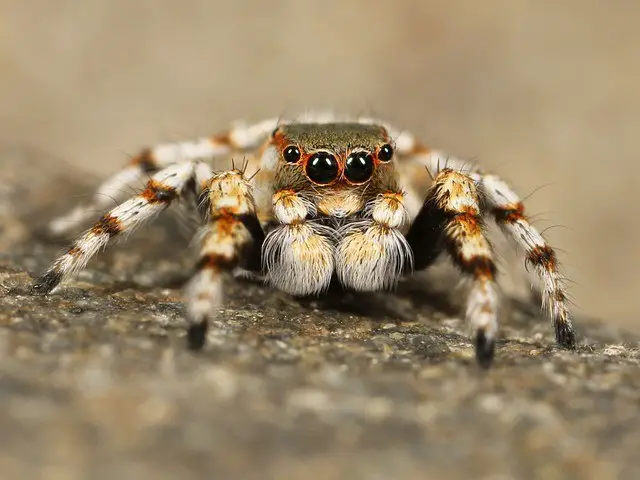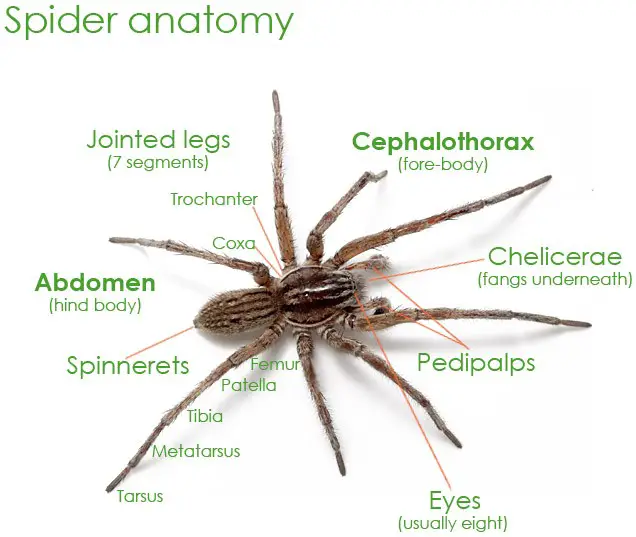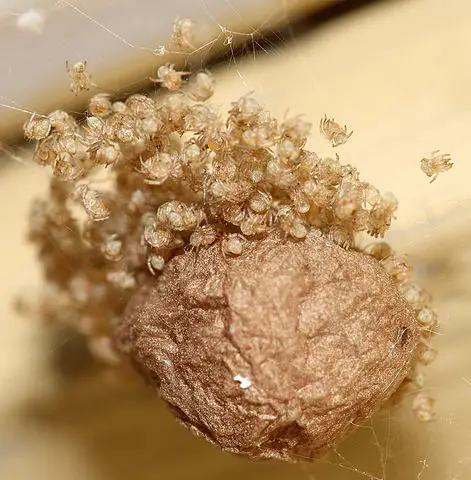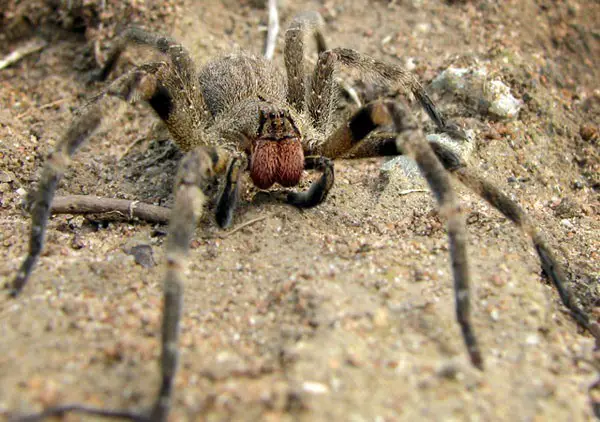Spiders are an important part of our ecosystem. There are more than 48000 species of Spiders in the world. We have gathered a complete set of Spider Facts For Kids that will help you in learning all about spiders. You are going to learn its scientific name, classification, spider family tree, characteristics, senses, body parts, brain, heart, appearance, legs, eyes, size, color, male, female, lifespan, life cycle, spider web, diet, prey, food chain, ecosystem, reproduction, eggs, spiderling, behavior, poison, sting, endangered, benefits and many other interesting facts about the Spider. You will get here all the Spider Information For Kids you need
Spider Facts For Kids
1. What Is A Spider
- Spiders are invertebrates of the Phylum Arthropoda.
- They belong to Subphylum Chelicerata, which means they have Chelicerae (special mouthparts commonly called “jaws”) with fangs capable of venom injection.
- They have eight legs and they breathe air.
- Spiders are found throughout the world except for Antarctica.
- Except for the sea and air colonization, spiders can establish in almost every type of habitat.

2. What Is The Scientific Name Of A Spider – Spider Scientific Name
- The scientific name of the spider is “Aranea”.
3. Spider Classification – Spider Taxonomy
- The following is the scientific classification or taxonomy of spiders:
| Kingdom | Animalia |
| Phylum | Arthropoda |
| Subphylum | Chelicerata |
| Class | Arachnida |
| Order | Araneae |
| Suborders |
|
| Families | 120 |
| Species | 48,000 |
4. What Do Spiders Look Like – Spider Appearance
- Their body is divided into two parts:
- a prosoma
- an abdomen.
- They have eight legs.
- They have several eyes.
- They do not have wings and antennae-like other insects.
- They have tiny little hands attached to their mouth called pedipalps.
- They also have fangs and other mouthparts called chelicerae which help them in eating.
- They have spinnerets on their tail for spinning the web.
5. How Many Species Of Spiders Are There – Spider Species
- In July 2019, taxonomists recorded 48,200 species of spiders that belong to 120 families.
6. Spider Family Tree
- Scientists have agreed now that spiders are “Monophyletic”.
- The monophyletic group means a group of organisms that have a common ancestor.
- The following evolutionary family tree was proposed in 2007, which is based on the analysis of J. W. Shultz.
- Chelicerata
- Xiphosura (horseshoe crabs)
- Eurypterida [extinct]
- Chasmataspidida [extinct]
- Arachnida
- Scorpiones
- Opiliones (harvestmen)
- Pseudoscorpiones
- Solifugae (sun spiders)
- Palpigradi (micro whip scorpions)
- Trigonotarbida [extinct]
- Araneae (spiders)
- Haptopoda [extinct]
- Amblypygi(whip spiders)
- Thelyphonida(whip scorpions)
- Schizomida
- Amblypygi(whip spiders)
- Haptopoda [extinct]
- Araneae (spiders)
- Ricinulei (hooded tick spiders)
- Anactinotrichida Acariformes
- Acariformes (mites)
7. Spider Characteristics – Spider Physical Characteristics – Spider Features
- There are several features of spiders, which link them with other Arachnids. It includes:
- Segmented body into two sections
- Eight legs that have joints
- Absence of antennae or wings
- Simple eyes
- Presence of pedipalps and chelicerae
- The presence of an exoskeleton, which they shed periodically
8. Spider Senses
- Spiders have the senses of sight, touch, and some others.
- Spiders usually have eight eyes arranged in patterns on the front region of their Cephalothorax. Their eyes are of two types called the “Primary eyes” and the “Secondary eyes”. Through the Primary eyes, spiders detect the direction of light as well as form images.
- The cuticles (body covering) of spiders are modified into a complicated array of sensors.
- Of these sensors, the setae (the bristles or hair) are the touch sensors, which respond to different degrees of touch; from weak air currents to powerful contact.
- Spiders also have chemical sensors, which provide them the senses of taste and smell through chemosensitive setae. The chemosensitive hair is mostly located on the tarsi of the first pair of their legs. Males have more chemosensitive hair than females and are observed responding to female sex pheromones (chemical secretion of arthropods).
- Spiders also possess Slit sensilla or slit sense organs in the joints of their limbs. It detects vibrations, forces, and physical deformations caused by forces.
9. Spider Body Parts
- Spiders have two major body parts:
-
Cephalothorax or Prosoma
- This part is a fused head and thorax.
- Eyes, mouthparts including chelicerae, pedipalps, and eight walking legs are attached to the cephalothorax.
- Each leg is composed of 7 segments.
- The legs have claws on the tips which vary in number from species to species.
- The legs also have setae or sensitive hair, which helps them to detect sounds, smells, air currents, and vibrations.
- The cephalothorax is attached to the abdomen through a thin and flexible organ called a pedicel.
- The pedicel is so flexible that it enables a spider to move its abdomen in all directions without moving its cephalothorax.
-
Opisthosoma or abdomen
- The abdomen is the second major part of a spider’s body.
- The front side of the abdomen has two hundred plates called the epigastric plats.
- These plates cover the book lungs (respiratory organ of the spider).
-

10. Do Spiders Have Brain – Spider Brain Facts
- Yes, spiders have concentrations of neural cells called “brain”.
- Their brain occupies most of the space within the cephalothorax.
- However, a spider’s brain is typically not like that of a vertebrates’ brain.
- It is made up of two nerve cell clusters or ganglia, linked to nerves and leading to various sensory organs and muscles.
- In most species, the brain extends down into the legs, such as in jumping spiders.
- It enables them to judge their jump and approach prey from behind.
11. Do Spiders Have Hearts – Spider Heart
- Unlike vertebrates, spiders have an open type of circulatory system.
- Spiders have a simple heart composed of a muscular tube with a one-way valve at each end.
- It pumps blood into the body cavity and the sinuses surrounding different tissues and organs.
- The blood of spiders is called hemolymph.
- The organs and tissues get oxygen, nutrients, and hormones because of being soaked in the blood.
12. How Many Hearts Does A Spider Have
- Spiders have only one muscular tube, which pumps blood and acts as a heart.
13. How Many Legs Does A Spider Have – Spider Legs
- Spiders have eight legs for walking.
- Each leg is composed of seven segments.
- From the body side, these segments are; the Coxa, Trochanter, Femur, Patella, Tibia, Metatarsus, and Tarsus.
- The tips of Tarsus have claws, which vary in size and number from species to species.
- Web spinning spiders usually have three claws while hunting spiders have two.
14. How Many Eyes Do A Spider Have – Spider Eyes
- Spiders usually have four pairs of eyes arranged in patterns on the front region of the Cephalothorax.
- Some other spider species have 3 pairs of eyes, some have two, some have only one pair, while some (such as cave-dwelling spiders) have no eyes.
- The pigment-cup ocelli are called the “principle eyes” located at the front. Principle eyes have eye muscles and can move the retina. These eyes are not only capable of detecting the direction of light but also of forming images.
- The other pairs of eyes are called “secondary eyes”.
- Secondary eyes are immobile and have no eye muscles.

15. What Size Are Spider – Spider Size
- The body size of spiders ranges from 0.02 to 3.5 inches (0.5 to 90 mm).
- Patu digua from Columbia is considered as the known smallest spider species with a body length of fewer than 0.015 inches (0.37 mm).
- Some spider species among tarantulas are the largest spiders, which reach a body length of 3.5 inches (90 mm) and have legs span up to 9.8 inches (250 mm).
What Is The Biggest Spider In The World
- By weight, Goliath birdeater is the biggest spider in the world.
- While by diameter and legs span, Giant Huntsman is the biggest spider in the world.
16. Colorful Spider
- Some of the colorful spider species are:
- Wasp spiders (Argiope bruennichi) have yellow stripes on their abdomen.
- Northern Jewelled spider (Gasteracantha fornicata) has complicated patterns on its abdomen.
- Northern Golden Orb Weaver (Nephila pilipes formerly known as N. maculata) has a golden color and reflects a lot of Ultraviolet light.
- Brown Huntsman spider (Heteropoda venatoria) has white strips beneath its eyes, which are so reflective that they even shine in the night and lure insects and moths towards the spider.
- Brazilian Crab Spider (Epicadus heterogaster) species have white, purple, yellow, and brown colors that resemble flowers.
17. Male Spider Facts
- Male spiders have a smaller body, larger legs, and bright colors in some species.
- In some species, they have swollen palps.
- Male spiders usually do not spin webs and are extremely active hunters.
- If kept as a pet or in the lab, male spiders usually need more space to roam.
18. Female Spider Facts
- In most species, female spiders are bigger.
- Females are also more venomous.
- In most spider species, females spin webs.
- In some species, females have a greater lifespan than males.
Difference Between Male And Female Spider
- Spiders have sexual dimorphism, which means a difference between male and female individuals of a species.
- Females have a larger size than males. In some species, females are about double the size of a male spider.
- Male spiders usually possess colorful patterns and bright colors to attract females.
- In venomous species, female spiders are more poisonous and possess more venomous vesicles than males.
- In some species, female spiders have a much longer lifespan than males.
19. How Long Do Spiders Live – Spider Age – Spider Lifespan
- Different species of spiders have a different lifespans.
- In some species, females live longer than males. For example, the male individuals of Goliath Birdeater, a common tarantula spider, have 15 years lifespan while females live for up to 25 years.
- Southern Black Widow spiders usually have a 1 to 3 years lifespan.
- Brown Recluse spiders live for 1 to 2 years.
20. Spider Life Cycle – Life of Spider
All the spider species generally have three stages of the life cycle;
-
The embryonic stage (egg)
- Male and female sider mate and the female then lay eggs, which vary in number from species to species.
- All the eggs are enclosed in an envelope or sac made up of strong silk.
- Depending on the spider species, there may be just a few to several hundred eggs in a single egg sac.
-
The immature stage (spiderling)
- After a few weeks, the immature spider called the spiderling hatch from the egg.
- Spiderlings are of a much smaller size and have an exoskeleton that protects them.
- They immediately disperse after hatching.
-
The sexually mature stage (adult)
- When a spider reaches maturity, they mate and start a life cycle again.
- The lifespan of spiders varies from species to species.
- Generally, female spiders have a longer lifespan than males.
21. Where Do Spiders Live – Spider Habitat Facts
- Spiders are terrestrial creatures and are almost always found on the land.
- Water spider (Argyroneta aquatica) is the only spider species exclusively found in water.
- Their habitat exists throughout the world except for Antarctica.
- Spiders have a diverse range of habitats from grasses and trees to deserts and lakes edges.
- They do well in all types of habitats where they are found.
22. Spider Web Facts – Spider Web Information
- Spiders create a structure from proteinous silk, which is known as a spider web.
- Spiders have silk-glands and a special silk-spinning organ called spinnerets.
- Catching prey is the general purpose of spinning webs.
- Usually, female spiders built a web in which she catches their prey and lay eggs.
- Not all species of spiders spin webs, while different species built different types of webs.
- Scientists believe that the webs of spiders have existed for a minimum of 100 million years.
What Does A Spider Web Look Like – Spider Web
- A spider web looks like a random haphazard construction, which lacks organization.
23. Types of Spider Webs
There are about five different types of spider webs they built in the wild. It includes:
-
Spiral Orb Web
- Orb web is the most familiar web of spiders.
- Members of the families Araneidae, Tetragnathidae, and Uloboridae built orb webs.
- They built it in a vertical plane, however, some species also build orb webs in a horizontal plane.
- Generally, an orb web is referred to as the spider web, which is still in use.
-
Cobweb or Tangle Web
- Spiders of the family Theridiidae weave cobwebs or tangle webs, which have a tangled three-dimensional structure.
- Typically, the word cobweb is used for the abandoned, dusty webs of spiders.
-
Funnel Web
- Spiders of the families Hexathelidae and Agelenidae built funnel webs.
-
Tubular Web
- Segestria florentina made tubular webs along with the ground or tree bases and in cracks of buildings.
-
Sheet Web
- Members of the family Stiphidiidae are called sheet web spiders as they make sheet webs.
- A sheet web is a horizontal sheet-like structure, which they usually built under rocks.
24. What Are Spider Webs Made Of
- Spider webs are made up of silk.
- While the silk is made up of a mixture of different types of protein crystals in a matrix of amino acids.
- Spiders have silk glands and a special organ known as “spinneret”, which produces silk from the silk glands.
- Different species of spiders use different types of silk for building webs, such as “fluffy” capture silk and “sticky” capture silk.
25. What Do Spiders Eat – Spider Diet – Spider Food (Spider Nutrition)
- Spiders are carnivores in nature and usually eat insects.
- Web-spinning spiders usually eat flying insects, such as flies, mosquitoes, butterflies, and moths.
- Some large spider species have also been observed eating other small animals like woodlice, millipedes, small frogs, lizards, and birds.
- Juvenile spiders of some families like Corinnidae, Clubionidae, and Thomisidae eat plant nectar.
- Some spiders feed on the pollen caught in their webs.
- Spiders also eat their old silk and have the ability to recycle its proteins for spinning new webs.
- Some spiders are also observed eating dead insects and abandoned silk of other spider species.
- Female spiders of most species kill and eat their relatively smaller-sized male mate when he is approaching her for mating.
26. How Do Spiders Catch Their Prey – Spiders Prey
- Web-building spiders usually do not have good eyesight. They use the vibration of the web strands to detect the position of the prey. When prey become trapped in their webs, they wrap it in silk and turn it circularly until it is completely covered.
- Jumping spiders and other species that do not spin webs hunt their prey.
- Most of them are extremely active hunters and catch the prey by chasing and then pouncing on them from behind.
- Most spiders also inject venom into prey and make them unable to move.
- Some spiders use unique methods for capturing prey, such as:
-
- Using bolas (a sticky blob of silk at the endpoint of a line) is a method of attracting the prey. When flying moths come near the bola, the spider snags it. This act is just like a fisherman snagging fish on the hook. That is why bola spiders are also called fishing spiders or angling.
- Some spiders hunt along the edges of lakes or streams. They usually hunt with their forelegs and body within the water, while their back legs hold on to the shore.
- Some spiders build burrows with trap doors made up of vegetation, soil, and silk. The trap door is hinged with silk on one side and has a soil-like appearance when closed. The spider stays inside the burrow and waits for prey. When prey reaches near the burrow, its movement disturbs the “trip” lines and the spider detects its vibration and becomes alert. When the prey comes close to the trap door, the spider jumps out of its burrow and catches it.
- Some spiders use deception methods for hunting other spiders. In this method, the spider mimics the motions of a captured insect in the webs of other spiders. When the web owner attracts, the spider pounces and captures him. Portia, a jumping spider, uses this method.
- Some spiders form baskets from their legs and release a pheromone to attract prey.
27. How Do Spiders Eat Their Prey
- Most Arachnids including spiders and scorpions have a narrow gut.
- The gut has two sets of filters, which only allow liquid food to pass and keep solids out.
- There are two different systems of external digestion and every spider species use one of them:
- Spiders inject digestive enzymes from their midgut into the prey. The enzymes liquefy the tissues, which they then suck into their guts, and finally the empty husk of the prey body left behind.
- In other methods, spiders use their chelicerae and the bases of the pedipalps to grind the prey, while dropping a large number of enzymes to liquify it. In species using this method, the chelicerae and pedipalps form a cavity which they use for holding the prey during processing.
28. Spider Food Chain
- Spiders are carnivores and eat insects, such as flies, ants, bees, butterflies, and moths.
- Spiders then become the food of other carnivores, such as birds, lizards, spider wasps, and even bigger spiders.
29. Spider Ecosystem
- Spiders are an important part of every ecosystem.
- They control the number of insects and bugs that can destroy plants and crops.
- In homes, they eat indoor insects including mosquitoes, flies, earwigs, cloth moths.
- Shortly, controlling the insect population is their primary role in every ecosystem.
30. How Do Spiders Reproduce – Spider Reproduction
- Spiders undergo sexual reproduction.
- The eggs and sperms fertilize internally but in an indirect way, which means males do not have special genitals to insert sperm into the female’s body.
- Male spiders spin small sperm webs and ejaculate sperm onto them.
- They then transfer their sperm into pulpal organs (or pulpal bulbs).
- Pulpal organs are syringe-like structures that exist on the tips of the pedipalps in mature male spiders.
- Female spiders have one or two openings on the underside of their abdomen through which they receive sperm.
- When males find mature females of the same species, they inject sperm from their pulpal organs into the female’s openings.
- The females store the sperm in spermatheca (a sperm storage region inside the female’s body) and fertilize their eggs.
- She then lay eggs in a sac made up of silk.
- An egg sac may have few to many hundreds of eggs.
- After two to three weeks, young spiders hatch from the eggs.
31. What Do Spider Eggs Look Like – Spider Egg Facts
- The eggs of spiders have a fluid’s drop-like appearance.
- Spiders lay their eggs in a special structure known as an egg sac.
- Females made egg sacs from silken threads in which she then deposits her eggs.
- The sac has a ball-like structure and is tough enough to protect the eggs.
- A single egg sac may have 2 to 1000 eggs depending on the species.

32. Spider Egg Hatching – Spider Eggs on Wall – Spiders Hatching
- Spiders usually protect their egg sacs by hiding them within the web or fixing them with a wall or hard surface.
- In some species, females carry their egg sacs until hatching.
- The young ones hatch from the eggs after two to three weeks.
- They open the wall of the egg sac and come outside.
- In some cases, mothers open the sac.
33. Newborn Spider Facts
- Newborn spiders are called spiderlings.
- They are immature and look like tiny adults.
- After hatching, the newborn spiders disperse through walking or a special behavior known as ballooning.
- When dispersing through ballooning, spiderlings climb onto projecting objects such as twigs.
- Their spinnerets (silk-spinning organs) release silk threads, which carry them away through the air currents.
- Spiderlings have an exoskeleton, which they repeatedly shed.
- In most spider species, the spiderlings become mature after shedding their exoskeleton 5 to 10 times.
What Are Baby Spiders Called?
- A baby spider is called a spiderling.
34. Spider Behaviour Facts
- Spiders perform a wide range of behaviors and activities.
- Many spiders weave webs which they use for catching prey.
- However, not all spiders build webs and capture their prey through a lot of methods, such as: using the bola method, building borrows with cork-like trapdoors, forming baskets from their legs, and deception method.
- Jumping spiders have excellent eyesight. They usually pounce upon the prey while sometimes chasing them from a distance.
- Spiders also show cannibalism behavior under various conditions. For example, female Australian redback spiders eat their male mates before, during, or after mating. Male water spiders eat females of smaller sizes. In some species, the newborn offspring eat their mother. In some cases, females die during protecting their eggs and the newborns then eat them. Some spider species eat individuals of their kind in case of food scarcity, for example, Pholcus phalangioides.
- Male spiders usually use courtship rituals to avoid the large-sized female from eating them. In web-building species, these rituals include vibration patterns on the web. In hunting spiders, the males hypnotize the females with patterns of touches on her body.
- The majority of spider species are solitary and even become aggressive towards individuals of their kind. However, some spider species show sociality. For example, Anelosimus eximius is a species that show higher sociality and in some cases, lives in groups of more than 50,000 individuals.
35. Poisonous Spiders
- Of all the 48,000 species of spiders, about 30 are considered poisonous and have been responsible for causing human death.
- However, such cases are very rare since hospitals, clinics, and poison control centers usually have species-specific antivenin (antitoxins) for the treatment of a spider’s bite.
- In people, the venom of poisonous spiders produces lesions on the skin or causes a fatal allergic reaction.
Top 10 Most Poisonous Spiders – Top 10 Deadliest Spiders
- The following are the top 10 most poisonous and deadliest spider species:
- Brazilian wandering spider
- Black widow spider
- Brown widow spider
- Brown recluse spider
- Six-eyed sand spider
- Chilean recluse spider
- The Northern funnel-web spider
- The Sydney funnel-web spider
- Wolf spider
- Red-legged widow spider
36. Spider Sting
- Unlike wasps, spiders do not have any organ for sting but rather they bite through chelicerae and inject venom through fangs.
- The injury results from a spider’s bite are known as arachnidism.
- Most spider bites do not cause any serious effects and only lead to mild symptoms around the area of the bite.
- However, bites of some spiders cause severe pain and necrotic wounds on the skin.
- For example, the bite of widow spiders (of the genus Latrodectus) causes a condition known as Latrodectism. The symptoms include severe pain, muscle cramps, vomiting, and sweating.
- Bite of the recluse spiders leads to a condition known as loxoscelism. In this condition, necrosis of the surrounding skin occurs. Widespread hemolysis (rupturing or breakdown of the Red Blood Cells) may also occur. The symptoms include vomiting, headaches, and fever.
- The Australian funnel-web spider and the South American wandering spider are other spider species that can cause severe bites.
37. The most Dangerous Spider – Deadliest Spider
- The Brazilian Wandering Spider is regarded as the most dangerous and deadliest spider.

38. Are Spiders Endangered
- Before 1994, insects and arachnids have not been considered to be included in the list of threatened and endangered species.
- In 1996, up to eight spider species found in the United States were included in the IUCN Red List of Threatened Animals.
- Of these, one species was listed as Endangered, three species were listed as Vulnerable, and five were considered as Data Deficient.
39. List Of Endangered Spiders – Endangered Spiders Species
- Currently, the following species of spiders are considered Endangered:
-
- Spruce-fir moss spider (Microhexura montivaga)
- Kauai cave wolf spider (Adelocosa anops)
- Katipo (Latrodectus katipo)
- IUCN listed the following species as vulnerable:
-
- Dolloff cave spider (Meta dolloff)
- Great raft spider (Dolomedes plantarius)
40. Why Are Spiders Important – Benefits Of Spiders
- Spiders eat pests and other insects including mosquitoes in homes.
- They also eat agricultural pests in crop fields and reduce the need for pesticides.
41. Interesting Facts About Spiders – Fun Facts About Spiders
- Spiders are found throughout the world except for Antarctica.
- Among all the groups of organisms, spiders have the 7th rank in total species diversity.
- Some spider species are classified based on the webs they weave.
- Spider silk is one of the strongest and toughest natural fibers. Its strength is about as half as that of steel. While due to its extensibility, it is considered to be tougher than steel.
- A spider may be capable to produce as maximum as six different types of silk. They use silk for weaving webs, capturing prey, traveling, and building egg cocoons.
- Spiders can eat their silk and recycle its proteins needed for the creation of new webs.
- Jumping spiders have about 5 times weak eyesight than human beings.
- Spiders do not have any balance or acceleration sensors. They depend on their eyes to orient their way.
- The blood equivalent of spiders is called hemolymph. It contains hemocyanin (copper-containing protein molecules) instead of hemoglobin (iron-containing protein molecules). Hemocyanin is a much weaker oxygen carrier than hemoglobin.
- The Brazilian wandering spiders are considered the world’s most dangerous spiders. Its venom is an extremely powerful neurotoxin. It is up to 20 times more fatal than the venom of a Black widow spider if gets into the bloodstream of a person.
- Spiders are not insects (insects have 6 legs). They are arachnids and have 8 legs. Other members of its class are scorpions, harvestmen, mites, and ticks.
- All spiders have silk glands and spin silk. However, not all spiders spin webs.
- In the spider’s body, muscles lay inside while an outer skeleton known as exoskeleton protects the muscles and other body parts.
- In Cambodia, cooked or fried tarantula spiders are considered a delicacy.
42. Spiders FAQs
What Is Arachnophobia
- Arachnophobia is the abnormal fear of spiders or anything resembling or related to spiders, such as spider-like shapes and spider webs.
- It is a specific phobia.
- According to some statistics, about 50% of women and 10% of men show the symptoms of arachnophobia.
What Do Spiders Hate
- Spiders hate the smells of many things, which can be used to keep them away.
- It includes the smell of citrus fruits (such as lemon and orange), tea tree, eucalyptus, and peppermint oil.
- They also do not like the smell of vinegar.
Do Spiders Sleep
- Spiders do not sleep like humans.
- However, they have a daily cycle of rest and activity.
- When resting, they just lower their activity and metabolism to conserve energy.
- Spiders do not close their eyes during rest as it does not have any eyelids.
What is the Largest Spider In The World
- Giant huntsman is the world’s largest spider species.
- The leg span diameter of the mature individuals can reach about 12 inches (1 foot).
Can Spiders See Humans
- Among spider species, jumping spiders have excellent eyesight.
- Research has shown that juvenile jumping spiders can see their prey.
- So probably, they would also see humans.
What Is The Most Venomous Spider In The World – What Is The Most Poisonous Spider In The World
- According to the Guinness World Records, the male Sydney funnel-web spider is the world’s most venomous or poisonous spider for humans.
Most Deadly Spider In The World – Most Deadliest Spider
- The Brazilian wandering spider is considered the deadliest spider in the world.
Are All Spiders Venomous – Are All Spiders Poisonous
- Yes, all spiders are venomous.
- But the venoms or poison of not all spiders are dangerous to humans.
Are Jumping Spiders Dangerous
- All jumping spiders have venom.
- However, they are not dangerous to humans as they usually do not bite.
- Their bite is reported to be similar to that of a bee sting.
Are Garden Spiders Poisonous
- Like most other spider species, garden spiders also have venom.
- However, they are not aggressive and usually do not bite.
Are House Spiders Poisonous
- Of all house spiders, the Blackhouse spider is the most poisonous.
- However, their bite is not lethal.
- All house spiders are not aggressive and bite only when provoked.
Are Grass Spiders Poisonous
- Yes, grass spiders are poisonous.
- Their venom is hemotoxic (cause the breakdown of RBCs) but not dangerous like that of Brown Recluse.
- Grass spiders are not aggressive and bite only when provoked.








